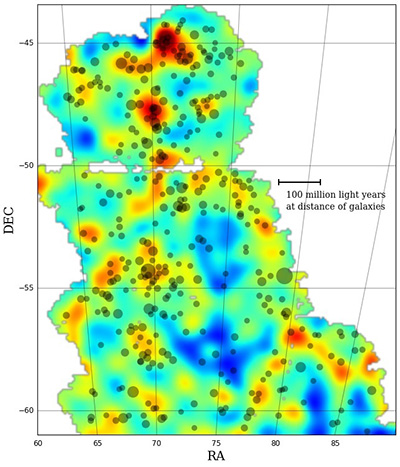Astronomers have made the first of a series of dark matter distribution maps in the universe.

The international project Dark Energy Survey , which united astronomers studying the nature of dark energy, published the first of the upcoming series of dark matter distribution maps in the Universe. The main goal of the project is to clarify the process of galaxy formation and how dark matter affects it.
In August 2013, 23 astrophysical organizations around the world launched a sky observation project, as a result of which scientists will receive a detailed description of the distribution of dark matter. The project uses a special digital camera Dark Energy Camera - this is one of the largest digital cameras, its resolution is 570 megapixels. It works on the basis of a 4-meter telescope located in Chile.
In two years from the beginning of the study, astronomers received 130 million photographs, which were then processed using supercomputers. Sarah Bridle, the lead astronomer, compares the amount of computation with 500 ordinary desktop computers that run continuously for two weeks.
')
Since dark matter interacts with ordinary matter only through gravity, it is impossible to see it. Its presence can be judged only by the effect of gravitational lensing, which distorts the light coming to us from distant galaxies. This is the distortion of images and processed by scientists.
“We measured the subtle distortion of the image of more than 2 million galaxies to create these maps,” says Vina Vikram, under whose leadership research is underway. “This is an indicator of both the high accuracy of the camera and the hard work that our team carried out to process this data.”
The data so far confirms the theory: since dark matter in the Universe is more than usual, then the formation of galaxies should occur around clusters of dark matter. In fact, these clusters are located just in the places where galaxies and whole galactic clusters were formed.
Source: https://habr.com/ru/post/366817/
All Articles